Some readers shared their perceptions after reading FC 174.
Tarun Kunzru says: “When it comes to self, the more one closes the gap between perception and reality, the more peaceful one will be. I always say to my friends who are past the magical 60 milestone — ‘welcome to the club where we don't give a damn about what others think anymore.’ What you see is what you get should be our mantra.”
Sanjiv Pai says: “Thanks for touching on the subtleties of perception. As my late mother's caregiver, I recall trying to perceive life through her limited faculties. This made me more empathetic. When a mentor/teacher perceives a topic through the eyes of a neophyte, he usually becomes more gentle.”
Senior Counsel K G Raghavan says: “Perceptions differ from opinions, judgements, or beliefs. Perceptions are less subjective than the others. The best example of perception is the description of the elephant by the six blind men. All were right. Though incomplete. All the great philosophers or vedantins gave us different perceptions of God's head, and all are right.”
S G Murali says: “Dear Pras, very nice strong Filter Coffee as usual. In the Corporate world, “Perception” matters a lot. The marketing team tries to build brands and create a favourable perception and top-of-mind awareness of their products. HR goes more by perception and perceived potential than actual performance in deciding promotions. In company meetings, rather than debating issues, people go by their perceptions of the person talking. Enjoy Nagaland.”
🎆 Hornbill Festival
The festival is named after the hornbill, the large and colourful forest bird which features in the folklore of the Nagaland State's many ethnic groups. The Hornbill, though made famous by the festival, is not the state bird of Nagaland. The Blyth Tragopan is the state bird.
Blyth's tragopan is a grey-bellied pheasant that is a vulnerable species. The name commemorates Edward Blyth (1810–1873), an English zoologist and curator of the Museum of the Asiatic Society of Bengal.
If you wish to know more about the Hornbill, please visit this very nice site: 🔗An Indian rainforest from a Great Hornbill's point of view — Google Arts & Culture
Come December, every year, from the 1st to the 10th, all roads lead to the Kisama Village, near Kohima, the capital of Nagaland. If you haven’t been to this festival, it is worth a visit just to tick an item off your bucket list. Getting there from down south involves a long haul, like going to Kolkata by air to take the connecting flight to Dimapur and then driving up to Kohima, a distance of 70 km on NH 39 in about 2 hours max, given the winding uphill roads and the traffic.
You can also drive to Dimapur from Guwahati, which is what we did. We could take the direct flight to Guwahati from Bangalore, spend a day there and then drive on NH 37 to Kaziranga en route to Dimapur.
The State of Nagaland became the 16th State of India on 1st December 1963. I am not sure if the Hornbill Festival (HBF) which starts on the 1st of December every year is intended to coincide with the date on which the State became part of India. We attended the 24th HBF and in 2024 the HBF will see its 25th edition unfold, which means the first festival was held in 2000. The festival showcases the cultural diversity of Nagaland’s tribes through traditional dances, music, sports, arts, and crafts.
The State has 16 recognised tribes. They are: Angami, Ao, Chakhesang, Chang, Kachari, Khiamniungan, Konyak, Kuki, Lotha, Phom, Pochury, Rengma, Sangtam, Sema, Yimkhiung and Zeliang.
All Indian tourists must apply for an Inner Line Permit (ILP). The Bengal Eastern Frontier Regulation 1873, which has been in force in the Naga Hills (present Nagaland), aims to protect and safeguard the identity and existence of the indigenous people of Nagaland. The Regulation makes it obligatory for anyone, both Indian Citizens and Foreigners, to obtain an ILP, which we did and got the ILP valid for 15 days. One can apply online: 🔗www.ilp.nagaland.gov.in. We did not encounter any specific point of entry where they checked, but you are expected to have an ILP. Some hotels may wish to see it as they would the passport in a foreign country.
My wife and I opted to witness the HBF on the 8th and the 9th day. The weather played truant on the 8th day and despite biting cold and the drizzle the tribal dances were performed with unabated enthusiasm which showed the sterner stuff the men and women are made of.
The 9th day was bright and sunny. All the 18 tribes were represented and when the roll-call was given, each tribe answered with their unique war cry, which was very impressive. The performances were very nice. Their sunbathed colourful dresses, the head gears and the plumes were a sight for sore eyes. The traditional attire of Nagaland is a visual delight, reflecting the tribes’ cultural identities. Men and women adorn themselves with intricately woven shawls with vibrant motifs and patterns. Some of their steps and moves may seem repetitive, but the spirit of the festival makes everything look different and engaging.
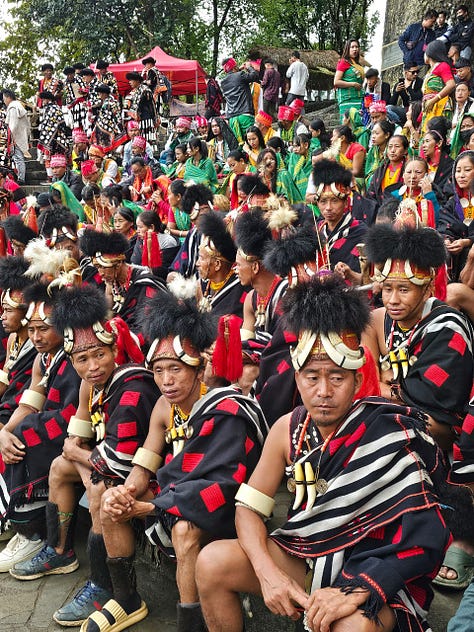
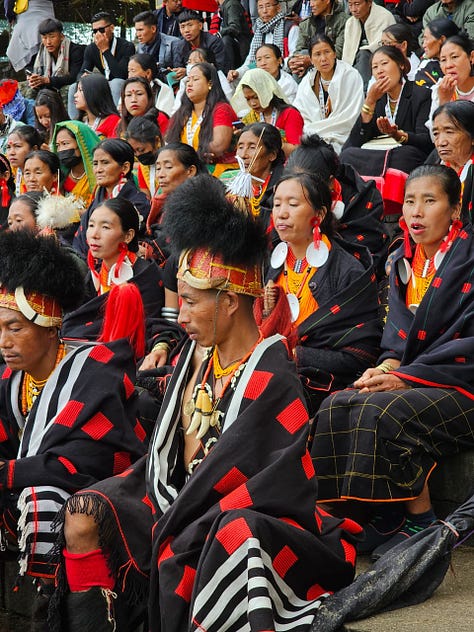
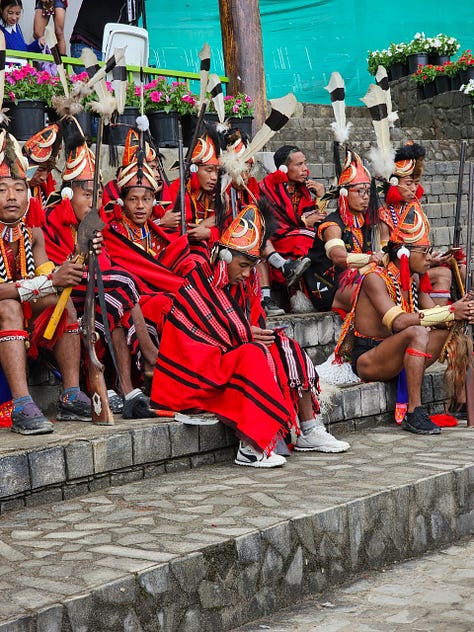

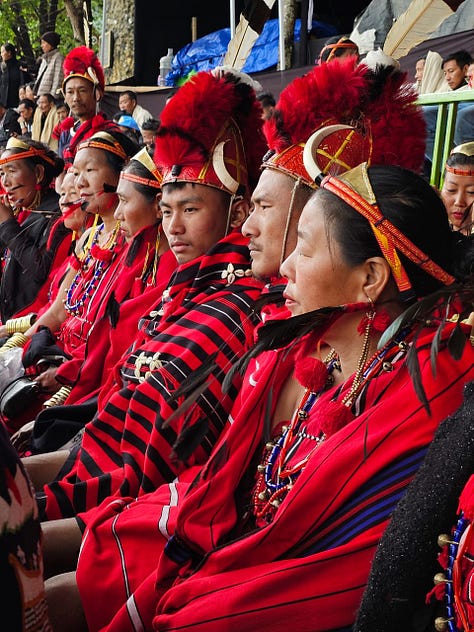

There were plenty of native shopkeepers selling their wares ranging from magnet souvenirs to colourful shawls, vest coats and a variety of accessories. To the spiritually inclined, there was rice beer served in a mug made of bamboo. My wife and I did not fancy the milky and sour liquid that reminded me of the rice kanji my mother used to make us drink when we were unwell.
The closing ceremony was on the 10th of December. The 10th day did not appeal to us as it was a litany of speeches and performances ranging from rock to fusion to tribal acts. If you have the time and interest, you can see the longer version of the closing ceremony on YouTube. Or else, here’s the short version: 🔗Closing Ceremony Hornbill Festival 2023
We left Kohima for Dimapur on the 10th after visiting the War Cemetery, which was perhaps one of the best-maintained cemeteries of soldiers of the British division of the allied forces slain in the 2nd world war in 1944. You can see more here 🔗Cultural Heritage of Nagaland's Kohima War Memorial - Explore Verve
As we entered Dimapur, the ‘commercial capital’, we found ourselves in a quagmire of traffic which lost the race to the snail. The town was surprisingly unappealing but mercifully and in sharp contrast Zone Naithu, the hotel where we stayed overnight, was an excellent property, the best we had on our entire tour. Our guide, whose pronunciation was flawed kept referring to it as ‘Naidu Hotel’.
But for the festival, there is no other attraction in Nagaland which would persuade one to do a long haul from Bengaluru to Kohima. We had been warned that vegetarian food is not easy to get, but our experience wasn’t too bad, and we managed to get a few vegetarian options.
Given the air travel, accommodation and a fair amount of road travel, the budget can be under some stretch, and you have to be prepared to take the bill by the horn. Speaking of horns, please read 🔗Filter Coffee #137 - by M R Prasanna, and 🔗Filter Coffee #146 - by M R Prasanna
To end in a lighter vein:
I made this up: Hornbill is what you get for honking in a silent zone.
One kid to another: “I want to buy a rain forest”
The other kid says: “Try Amazon”
Dear Readers, some of you may have been to the HBF. You can relive the experience. Those of you who haven’t been to the HBF, please go and experience the festive atmosphere but, most importantly, book hotel rooms in Kohima, at least 6 months in advance. (we stayed at the De Oriental Grand, a functional hotel, nothing fancy).
Hope you liked this post. Do write and tell me. Ciao, until next week.




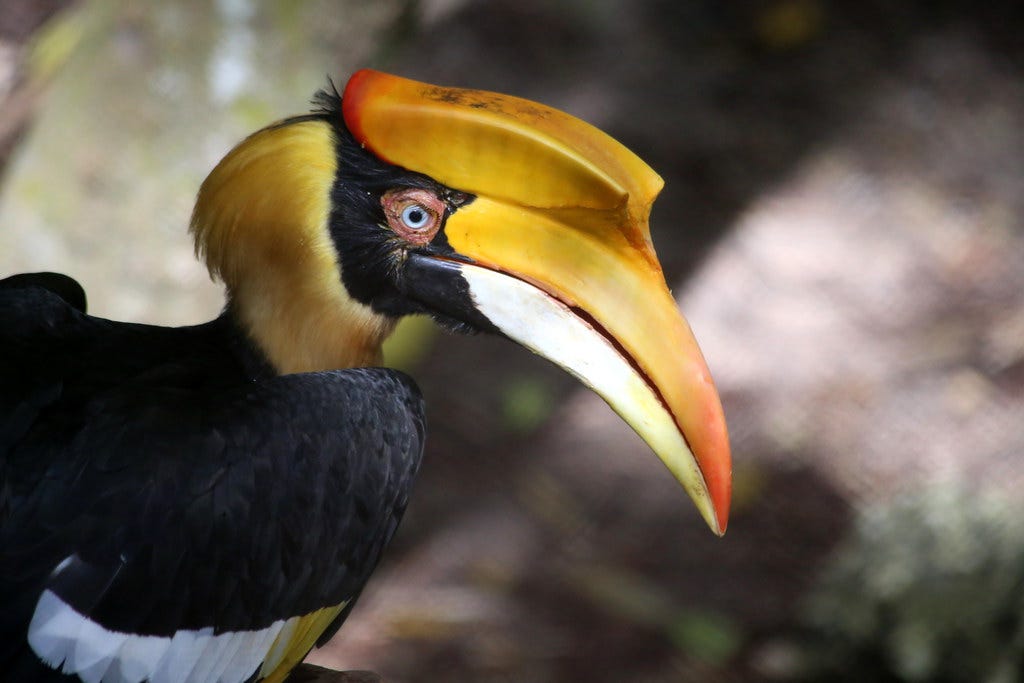



Pras, the lucidness of your travelogue compelled me to read it thrice! Your sentence, "We had been warned that vegetarian food is not easy to get, BUT....." told me that travel surely broadens the horizon of the mind. Travel usually demolishes stereotypes.
Welcome back! Thanks for the account of your refreshing and enriching holiday. Read with interest. So much to see and absorb in India.